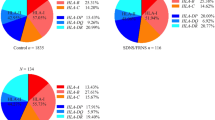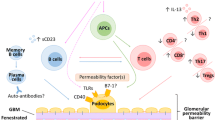Abstract
An increased frequency of specific major histocompatibility complex (MHC) class I, II and III antigens in children with steroid-responsive nephrotic syndrome (SRNS) has been reported. This frequency distortion, in some cases, is thought to affect the outcome of the disorder. We studied the phenotypic frequency of HLA antigens-A,-B, and-DR, as well as complement proteins Bf and C4 in an unrelated population of 25 SRNS children. Complete MHC haplotypes were also derived for four families in which 8 individuals developed SRNS. HLA-DR8, with a relative risk of 4.8, showed the strongest association with SRNS. Nonetheless, the 95% confidence intervals of this and the relative risks for all other antigens fell below 1.0. No common haplotype was found in SRNS patients in whom complete family studies were available, and disease and inheritance of the MHC were discordant in two of these families. In this study of well-characterized SRNS patients we were unable to discover a clear association between this disorder and the MHC.
Similar content being viewed by others
References
International Study of Kidney Disease in Childhood (1981) The primary nephrotic syndrome in children. Identification of patients with minimal change nephrotic syndrome from initial response to prednisone. J Pediatr 98: 561–564
Trompeter RS, Barratt TM, Kay R, Turner MW, Soothill JF (1980) HLA, atopy, and cyclophosphamide in steroidresponsive childhood nephrotic syndrome. Kidney Int 17: 113–117
Giangiacomo J, Cleary TG, Cole BR, Hoffsten P, Robson AM (1975) Serum immunoglobulins in the nephrotic syndrome. N Engl J Med 293: 8–12
Schnaper HW, Aune TM (1987) Steroid-sensitive mechanism of soluble immune response suppressor production in steroid-responsive nephrotic syndrome. J Clin Invest 79: 257–264
Lagrue G, Sobel A, Branellec A, Blanc C (1978) Etude d'une lymphokine agissant sur la permeabilite vasulaire. Ann Med Interne (Paris) 129: 57–60
McLean RH, Ruley EJ, Tina L, Medani D, Chesapeake Pediatric Nephrology Study Group (1986) Increased frequency of silent C4A allele (C4A*QO) of the fourth component of complement (C4) in the idiopathic nephrotic syndrome. Pediatr Res 20: 454A
McLean RH (1983) Increased frequency of factor B fast variant (BF*F) in the idiopathic nephrotic syndrome of childhood. Dis Markers 1: 25–32
McEnery PT, Strife CF (1982) Nephrotic syndrome in childhood: management and treatment in patients with minimal change disease, mesangial proliferation or focal glomerulosclerosis. Pediatr Clin North Am 89: 875–894
Mittal KK, Mickey MR, Singal DP, Terasaki P (1968) Serotyping for hemotransplantation. XVIII. Refinement of microdroplet lymphocyte cytotoxicity kit. Transplantation 6: 913–927
Welch TR, Beischel L, Balakrishnan K, Quinlan M, West CD (1986) Major-histocompatibility complex extended haplotypes in membranoproliferative glomerulonephritis. N Engl J Med 314: 1476–1481
Welch TR, Beischel L, Berry A, Forristal J, West CD (1985) The effect of null C4 alleles on complement function. Clin Immunol Immopathol 34: 316–325
Tiwari JL, Terasaki PI (1985)HLA and disease association. Springer, Berlin Heidelberg New York, pp 18–27
Miettinen OS (1974) Simple interval-estimation of risk ratio. Am J Epidemiol 100: 515
McDevitt HO, Bodmer WF (1972) Histocompatibility antigens, immune responsiveness, and susceptibility to disease. Am J Med 52: 1–8
Bell JI, Denny D, Joster L, Lee BSM, Hardy D, McDevitt HO (1986) Molecular biology of the class II response of the human major histocompatibility complex. Cold Spring Harbor Symp Quant Biol 51: 75–82
Fielder AHL, Walport MJ, Batchelor JR, Ryner RI, Black CM, Dodi IA, Hughes GRV (1983) Family study of the major histocompatibility complex in patients with systemic lupus erythematosus. Br Med J 186: 425–428
Raum D, Audeh Z, Glau D, Alper CA (1981) MHC-linked complement haplotypes (complotypes) in juvenile rheumatoid arthritis. Clin Res 29: 559A
Howell MD, Austin RK, Kelleher D, Nepom GT, Kagnoff MF (1986) An HLA-D region restricted fragment length polymorphism associated with celiac disease. J Exp Med 164: 333–338
Raum D, Awdeh Z, Gung EJ, Alper CA, Gabbay KH (1984) Extended major histocompatibility complex haplotypes in type I diabetes mellitus. J Clin Invest 74: 449–454
Klouda PT, Acheson EJ, Goldby FS, Lawler W, Manos J, Dyer PA, Harris R, Mallick NP, Williams G (1979) Strong association between idiopathic membranous nephropathy and HLA-DRW3. Lancet 2: 770–771
Kashiwabara H, Shishido H, Tomura S, Tuchida H, Miyajima T (1982) Strong association between IgA nephropathy and HLA-DR4 antigen. Kidney Int 22: 377–382
Berthoux FC, Gagne A, Sabatier JC, Ducret F, LePetit SC, Marcellin M, Mercier B, Brizard CP (1978) HLA-Bw35 and mesangial IgA glomerulonephritis. N Engl J Med 298: 1034–1035
O'Regan D, O'Callaghan U, Dunden S, Reen DJ (1980) HLA antigens and steroid responsive nephrotic syndrome of childhood. Tissue Antigens 16: 147–151
Thomson PD, Barratt TM, Stokes CR, Turner MW, Soothill JF (1976) HLA antigens and atopic features in steroid responsive nephrotic syndrome of childhood. Lancet II: 765–768
Alfiler CA, Roy LP, Doran T, Sheldon A, Baylir H (1980) HLA-Drw7 and steroid responsive nephrotic syndrome of childhood. Clin Nephrol 14: 71–74
Kobayashi Y, Chen X-M, Hiki Y, Fujii K, Kashiwagi N (1985) Association of HLA-DRw8 and DQw3 with minimal change nephrotic syndrome in Japanese adults. Kidney Int 28: 193–197
Noel LH, Descamps B, Jungers P, Bach JF, Busson M, Suet C, Hors J, Dausset J (1978) HLA antigens in three types of glomerulonephritis. Clin Immunol Immunopathol 10: 19–23
Chandra M, Mouradian MD, Hoyer JR, Lewy JE (1981) Familial nephrotic syndrome and focal segmental glomerulosclerosis. J Pediatr 98: 55–560
Welch TR, Berry A, Beischel LS (1987) C4 isotype deficiency in IgA nephropathy. Pediatr Nephrol 1: 136–139
McLean RH, Wyatt RJ, Julian BA (1984) Complement phenotypes in glomerulonephritis: increased frequency of homozygous null C4 phenotypes in IgA nephropathy and Henoch-Schönlein purpura. Kidney Int 26: 855–860
Tiwari JL, Terasaki PI (1984)
Author information
Authors and Affiliations
Rights and permissions
About this article
Cite this article
McEnery, P.T., Welch, T.R. Major histocompatibility complex antigens in steroid-responsive nephrotic syndrome. Pediatr Nephrol 3, 33–36 (1989). https://doi.org/10.1007/BF00859622
Received:
Revised:
Accepted:
Issue Date:
DOI: https://doi.org/10.1007/BF00859622




